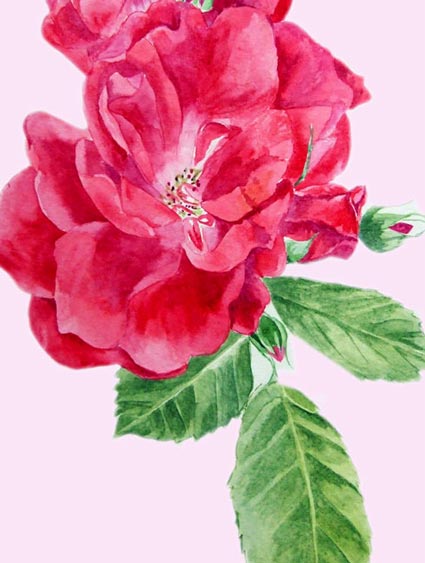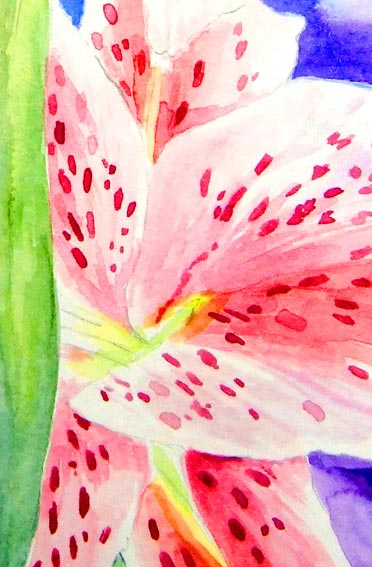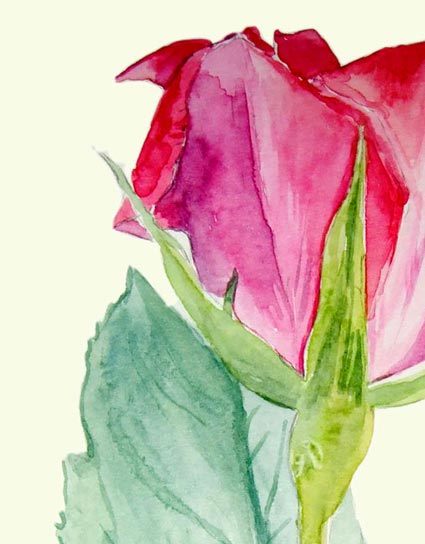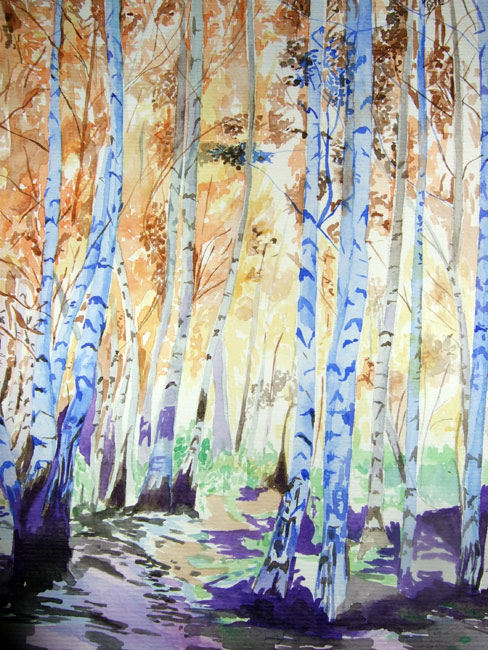Watercolour painter Melanie Chan interviewed by Gil Dekel.
Gil Dekel: You specialise in watercolour paintings of flowers. What do you see in the flower? [1]
Melanie Chan: I see the beauty of nature in flowers, and I am amazed by their perfection and their symmetry. Once I start painting my mind starts to become calmer, as if the flower is encouraging me to be in the moment. I pay particular attention to the way in which the light falls and how this changes the colours that can be seen. The colours of flowers can be vibrant, intense or delicate. [2]
Painting fresh flowers is my favourite form of watercolour painting. With fresh flowers there is the beauty in its temporality, its impermanence, which is very touching. At the start of a painting some petals may not be fully open but as the experience of painting unfolds in time, so do the petals. The Japanese have a special name for the fragility of things, which is mono no aware, like the fragility and beauty of the cherry blossom which blooms for just a short time. [3]
Once the flower painting is completed, do you see it in a different way compared with the real flower? [5]
The painted flower seems much less vibrant and less delicate. It is as if the flower’s natural perfection cannot be recreated entirely. There is a loss somehow in the translation process into a painted representation. The act of painting results in an image, which lasts longer than the flower itself, while the impermanence of the flower is, for me, far more beautiful and precious than any image of it. The image might evoke the beauty of the flower, but it is a token, a pale imitation of the wonderful, natural creation that was before me when I was painting. [6]
Nonetheless, the painted flower suggests the beauty of nature, so it acts as a kind of a reminder, reminding me to be attentive to the natural world around me. [7]
How do you start a flower painting? [8]
When painting flowers I start from the centre and move outwards. If I draw a portrait then I tend to start with drawing the eyes. But each watercolour painting is a different experience so there is no fixed formula or step-by-step technique that can be called upon. [9]
Why did you choose to use watercolours? [10]
The choice of watercolours is a practical one: I find them easy to transport and work with, and they dry easily. I also like the translucency of watercolour and watercolour paint effects, such as blending colours wet-on-wet. [11]
Can you say what you feel or think while painting? [13]
When I am painting flowers I tend to forget my emotions and lose myself in the moment of what I am doing. In this way I find it quite therapeutic as it tends to still my feelings and active ‘thinking’ on what is happening in my life or in the world. I prefer to be quiet when painting; it is in the silence, in the calm mind that the communion with the flowers can take place. However, if I am painting an abstract work in acrylic, then I am tuned into my emotions and let them steer me towards certain shapes, textures and colours. For example, I am often drawn towards blues, greens and flowing lines when feeling emotional or melancholy. At times when I am feeling joyful then my palette would be more vibrant, featuring orange, yellow or red. At other times, I will choose the colours according to the seasons. In summer time I prefer to use brighter colours, when the daylight is strong and the world around me seems to be full of light. [14]
Sometimes my artistic interpretation takes place so that the natural colours of the flowers are supplemented with emotional tones that I bring forward. For instance, when painting daffodils in spring, I might use lilac or even a touch of aquamarine on the petals to make the yellow of the flowers stand out even more. [15]
What inspire you to create art? [16]
I tend to get a feeling that draws me. Sometimes this might be a feeling to experiment with colour, or texture, or just experiment and see where things might go… Sometimes the feeling, or impulse to create, is an inner one based on a mood or memory. At other times it might be external, for example, a scene which might draw my attention. [17]
What happens when certain things draw your attention? [18]
I believe that inspiration is there most of the time, but usually my mind is elsewhere, busy thinking about the past or the future. So it is often necessary to make time to be mindful, to pay attention to nature and it is then that I get a kind of urge to express that relationship. If I do not express that urge, then I feel blocked and irritable like a dam that holds back the water. [19]
What is inspiration? [20]
Inspiration is the creative force of life itself and the Universe. I read a great metaphor recently which illuminated the inspirational process. The metaphor is that the light, or inspiration, is always shining. However, some people draw heavy curtains around their windows so only a bit of light comes through. But if we allow our consciousness to be like sheer curtains, then more light is able to shine through us… [21]
Is the way you paint affected by any of your beliefs about life? [23]
Yes, I think it would be very difficult to separate the two. Creativity is life; there is no separation for me of these two elements. I feel that painting is a part of who I am. I could not imagine not painting, since it is an expression of life and intrinsic to life, like breathing or eating. [24]
You have completed your PhD recently. Is there any relation between writing PhD thesis (using words) and painting (using images)? [25]
I think that words conceptualise and divide the world into binary categories of subject and object. Painting, on the other hand, is like being open to the light of inspiration, and allowing it to flow through me and gain expression. Artistic expression seems to exceed the conceptual boundaries of language; it is more whole somehow. [26]
The academia and its conventions of celebrating thought can help to explain or understand art, yet academic words about art and the process of making art are formal processes which are different from making art. Academic writing is for me, less free-flowing than making watercolour images. [27]
For example, I am often surprised by the range of colours that can be seen in a single petal and realise that it is only by paying attention and spending time looking at the flower that these can be noticed. Paying attention in this way brings me to a state of relaxed awareness, which Buddhists call mindfulness. Mindfulness is different from the analytical concentration that takes place when reading a text, or writing a thesis. Mindfulness is for me an act of entering into a sort of communion or shared experience with the creative impulse that forms each living thing. I am looking intently yet also gently at the flowers before me, and it draws me into a non-verbal communication experience. This is why I prefer to be quiet when painting. [28]
Dr. Melanie Chan is facilitating a course in Optimal Thinking which focuses on developing positive supportive ways of thinking and challenging our negative thoughts. Contact us to learn more or to book your place.
24 July 2008. Figure 4 uploaded 19 Feb 2012.
Images © Melanie Chan. Text © Melanie Chan and Gil Dekel.
Interview conducted via email correspondence (May-July 2008).
Melanie Chan is based in Leeds, UK. Gil Dekel is based in Southampton, UK.






 - Reading with Natalie, book here...
- Reading with Natalie, book here...